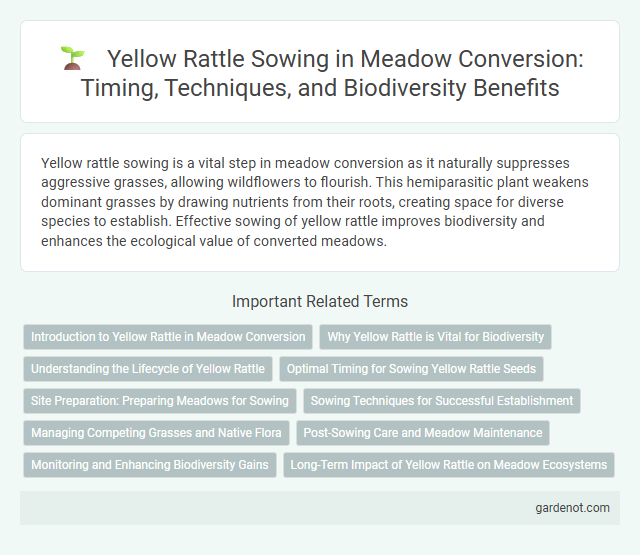Yellow rattle sowing is a vital step in meadow conversion as it naturally suppresses aggressive grasses, allowing wildflowers to flourish. This hemiparasitic plant weakens dominant grasses by drawing nutrients from their roots, creating space for diverse species to establish. Effective sowing of yellow rattle improves biodiversity and enhances the ecological value of converted meadows.
Introduction to Yellow Rattle in Meadow Conversion
Yellow Rattle (Rhinanthus minor) is a semi-parasitic annual plant that suppresses vigorous grasses, creating gaps for wildflowers to establish in meadow conversion projects. Sowing Yellow Rattle at a rate of 4-10 grams per square meter in early autumn enhances biodiversity by reducing grass dominance and promoting a diverse flora structure. This species plays a critical ecological role by balancing sward competition, ultimately facilitating the transition from dense grassland to species-rich meadows.
Why Yellow Rattle is Vital for Biodiversity
Yellow Rattle (Rhinanthus minor) is vital for biodiversity because it acts as a hemiparasite, suppressing dominant grasses and allowing wildflowers to flourish, thereby increasing species richness in meadow ecosystems. Its presence enhances habitat complexity, supporting a diverse array of pollinators and insect populations critical to ecological balance. By promoting floral diversity, Yellow Rattle contributes significantly to the restoration and sustainability of native meadow habitats.
Understanding the Lifecycle of Yellow Rattle
Yellow rattle (Rhinanthus minor) is an annual hemiparasitic plant that completes its lifecycle within a single growing season, vital for meadow conversion. It relies on host grasses for nutrients, attaching to their roots early in spring to suppress grass growth and promote wildflower diversity. Sowing yellow rattle seeds in late autumn ensures stratification, enhancing germination rates while aligning its growth cycle with meadow restoration goals.
Optimal Timing for Sowing Yellow Rattle Seeds
Optimal timing for sowing yellow rattle (Rhinanthus minor) seeds is crucial, with late summer to early autumn, typically between August and September, being ideal for best germination rates. Sowing during this period allows seeds to undergo natural cold stratification over winter, enhancing seed viability and ensuring effective parasitism on grasses in the following growing season. Proper timing maximizes the establishment of yellow rattle, which plays a key role in meadow conversion by reducing grass dominance and promoting wildflower diversity.
Site Preparation: Preparing Meadows for Sowing
Effective site preparation is crucial for successful Yellow Rattle sowing in meadow conversion, involving the removal of dense grasses and weeds to reduce competition. Techniques such as scarification or shallow cultivation help create an open seedbed, enhancing seed-to-soil contact and germination rates. Ensuring bare patches of exposed soil fosters Yellow Rattle establishment, which in turn suppresses dominant grasses and promotes wildflower diversity.
Sowing Techniques for Successful Establishment
Yellow rattle sowing requires precise seed-to-soil contact through shallow broadcasting or light raking to ensure germination. Optimal sowing should occur in late summer or early autumn when soil temperature ranges between 10-15degC, enhancing seed dormancy break and establishment. Combining scarification with mowing existing grassland beforehand reduces competition and promotes successful yellow rattle growth.
Managing Competing Grasses and Native Flora
Yellow rattle (Rhinanthus minor) sown in meadow conversion effectively suppresses dominant competitive grasses by parasitizing their roots, reducing their vigor and allowing native wildflowers to flourish. Optimal sowing density ranges from 5 to 10 seeds per square meter to balance grass control without overly diminishing overall meadow biomass. Timely sowing in autumn ensures seed stratification and successful germination, promoting sustainable native flora diversity and meadow ecosystem health.
Post-Sowing Care and Meadow Maintenance
After yellow rattle sowing, maintain consistent soil moisture to ensure seed germination and early growth, avoiding waterlogging that can inhibit development. Regularly monitor the meadow for competing grasses, implementing light grazing or mowing after flowering to prevent dominance and promote yellow rattle establishment. Annual assessment of soil nutrient levels helps maintain the low-fertility conditions favored by yellow rattle, supporting overall meadow biodiversity and successful conversion.
Monitoring and Enhancing Biodiversity Gains
Consistent monitoring of yellow rattle sowing is essential to evaluate its impact on biodiversity gains in meadow conversion projects. Tracking seedling establishment, flowering rates, and seed production informs adaptive management strategies that enhance native wildflower diversity and suppress dominant grasses. Data-driven interventions optimize habitat complexity and support pollinator populations, reinforcing ecosystem resilience.
Long-Term Impact of Yellow Rattle on Meadow Ecosystems
Yellow rattle (Rhinanthus minor) acts as a hemi-parasitic plant that suppresses dominant grasses, enhancing biodiversity and promoting wildflower diversity in meadow ecosystems. Its long-term impact includes increased plant species richness and improved habitat structure for pollinators and ground-nesting birds. Persistent yellow rattle populations contribute to sustainable meadow restoration by maintaining balanced plant community dynamics over multiple growing seasons.
Yellow rattle sowing Infographic

 gardenot.com
gardenot.com